People with certain older generations of Apple iPhones, iPads, and iPods should install a new security update, said the California-based tech giant.
In a recent notice, Apple Inc. noted that a security vulnerability was recently discovered via Google’s Threat Analysis Group.
Because of the flaw, it’s possible that users with older-generation Apple devices that use iOS could have problems with “maliciously crafted web content [that] may lead to arbitrary code execution,” according to Apple.
Story continues below advertisement
The devices impacted by the flaw are the iPhone 5s, iPhone 6, iPhone 6 Plus, iPad Air, iPad Mini 2, iPad Mini 3, and the six-generation iPod touch, the firm said. An update for iOS 12.5.7 is now available on Apple’s website or via the devices.
“Apple is aware of a report that this issue may have been actively exploited against versions of iOS released before iOS 15.1,” the firm said, adding the security bug is a “type confusion issue was addressed with improved state handling.”
How to Update
In the update the following services, systems, and apps are addressed: AppleMobileFileIntegrity, curl, dcerpc, DiskArbitration, DriverKit, Intel Graphics Driver, PackageKit, Kernel, Mail Exchange, Maps, Screen Time, Weather, WebKit, and Windows Installer, according to AppleInsider.If the update hasn’t been applied to a device, it can be manually implemented by going to Settings > General > Software Update. Then users can tap Download and Install. Most users will then be prompted to input the passcode for the iPhone.
People who have automatic updates enabled generally won’t have to do anything to apply the update, as it was most likely installed overnight when it was released last week.
New iOS
Last year, Apple announced four new operating system (OS) updates during its Worldwide Developers Conference event. There, it was announced that iPhone 7 models and earlier won’t get iOS 16.At the time, the firm drew backlash from users who claimed Apple was forcing them to buy new devices in order to upgrade to iOS 16.
“As the following chart shows, Apple has done a good job over the years of keeping older devices in the loop for a long time. While the original iPhone and the iPhone 3G received two major iOS updates, later models have typically gotten software updates for five to six years,” according to an analysis published by Statista last year. “Having been shipped with iOS 9, the iPhone 6s became the first generation to see a seventh iOS version, making it the technological equivalent of a tortoise outlasting generations of humans.”





